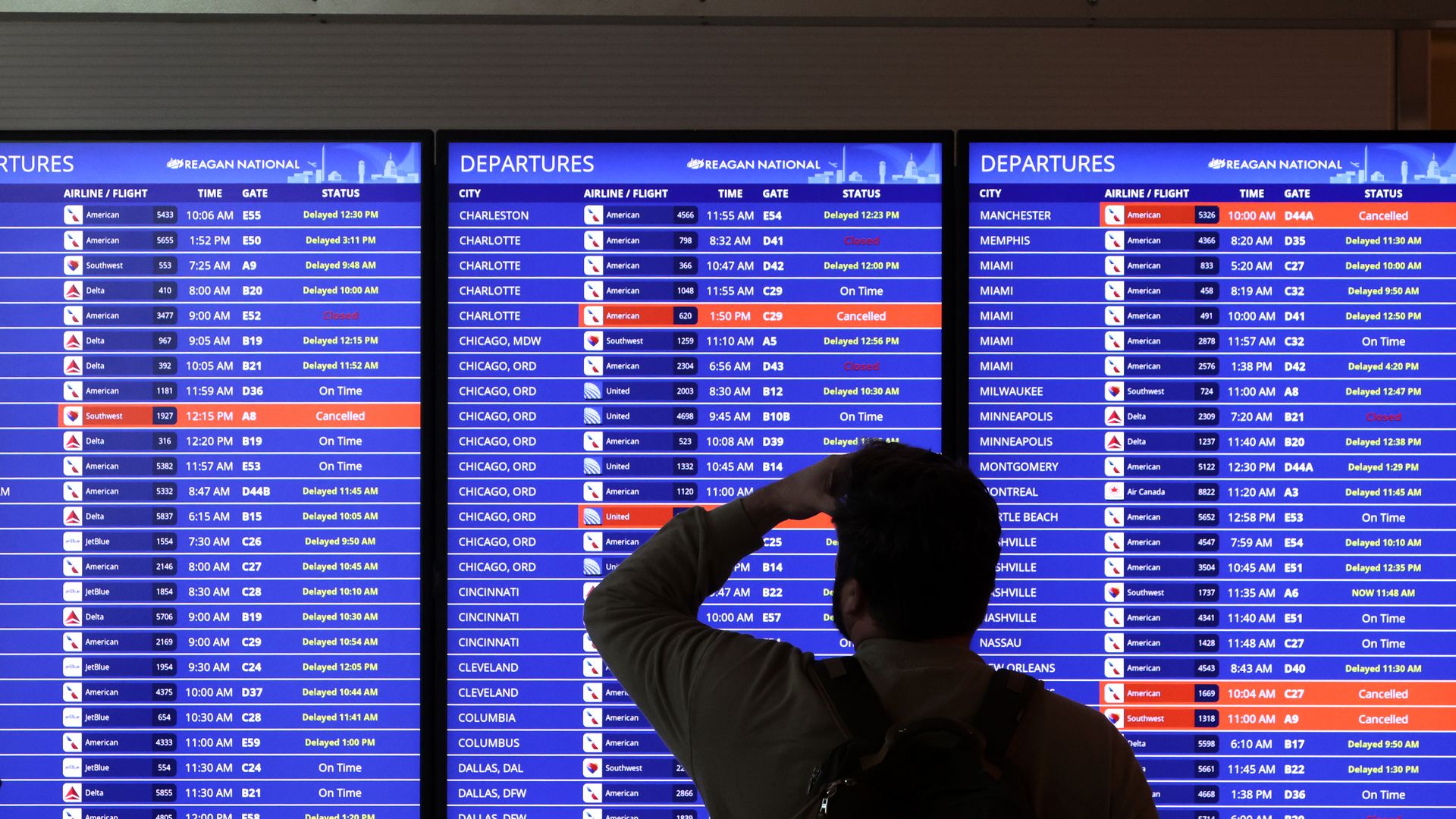| | | | | | | Presented By Salesforce | | | | Axios What's Next | | By Joann Muller, Jennifer A. Kingson and Alex Fitzpatrick · Jan 12, 2023 | | Between the airlines and the FAA, there's plenty of work to be done on both sides to fix aviation's recent struggles, Joann writes today. Today's newsletter is 1,206 words ... 4½ minutes. | | | | | | 1 big thing: Why air travel's been such a mess |  | | | A traveler looks at a flight information board at Ronald Reagan Washington National Airport on Jan. 11, 2023. Photo: Alex Wong/Getty Images | | | | There's plenty of blame to go around for the recent spate of delays and cancellations that have left travelers angry and cost airlines billions of dollars, Joann Muller writes. Driving the news: U.S. airline departures were grounded for several hours Wednesday morning amid an issue with a Federal Aviation Administration (FAA) system that sends pilots safety alerts and other critical info. - Normal operations resumed around 9 a.m. ET Wednesday — but the ripple effects could be felt for days in the form of further delays and cancellations.
- About 1,300 U.S. flights were canceled Wednesday as of 4 p.m. ET, while more than 9,000 were delayed, per FlightAware.
- The FAA suffered another computer issue on Jan. 2 that led to significant flight delays in Florida.
Backstory: Transportation Secretary Pete Buttigieg and the airline industry have been pointing fingers at each other for months about who's to blame for travel headaches dating back to last summer. - Responsibility for Wednesday's troubles falls squarely on the FAA.
- That's a turnabout for Buttigieg, who oversees the FAA and has been pushing to hold the aviation industry accountable for repeated disruptions — including Southwest's holiday meltdown.
- Buttigieg on Wednesday rejected the suggestion that the FAA should reimburse travelers for delays caused by its system failure, per Reuters.
What they're saying: "Today just encapsulates how archaic our aviation infrastructure system is," Brian Kelly, founder of travel website The Points Guy, told Axios. - "While the airlines, which are private companies, need to invest in their technology, so does the government. And as taxpayers, we have to hold the government accountable."
- The U.S. Travel Association, meanwhile, labeled Wednesday's disruption a "catastrophic" failure, and said federal lawmakers need to modernize air travel infrastructure to make sure the FAA can "meet demand safely and efficiently."
The intrigue: That's what some airline executives — notably United Airlines CEO Scott Kirby — have been saying for months. - "The FAA needs more funding for appropriate staffing … [and] we in aviation have to commit to helping them get that," Kirby told business leaders at a recent U.S. Chamber of Commerce aviation summit.
- "We need to modernize air traffic control. They're doing it with old technology, and they're doing it without enough staffing, and we have to fix that or nothing else is going to matter."
The big picture: Managing the skies is getting harder for a bunch of reasons: - More people are flying since the height of the pandemic, which means airlines are adding flights to their schedules and packing planes.
- But they've sometimes struggled operationally, partly due to staffing shortages, as they race to meet increased demand.
- The FAA, which has a stellar safety record, is also stretched to the limit as it tries to manage about 45,000 flights per day — including commercial airlines, cargo carriers and private planes.
- Plus, the national airspace is getting more crowded and complex with the addition of hundreds of thousands of drones, plus the occasional rocket launch and, soon, air taxis.
Of note: With climate change yielding more extreme weather events, hazardous conditions are becoming more of a factor in air travel, too. What's next: The FAA's five-year funding and authority are up for renewal by Congress later this year, and these issues will surely be under a microscope. Share this story. |     | | | | | | 2. The best cars and trucks of the year |  | | | The Acura Integra, Ford F-150 and Kia EV6. Photos courtesy of Acura, Ford and Kia | | | | The Acura Integra, F-150 Lightning and Kia EV6 are this year's North American Car, Truck and Utility Vehicle of the Year winners, Joann reports. - One of those — the all electric F-150 — lined up with my personal picks. My other choices: the Genesis G80 Electrified for car of the year and the Genesis GV60 for utility of the year.
Catch up quick: I'm on the jury, along with many other automotive writers. - I drove all 47 eligible vehicles over the last few months — including a record-setting 19 electric candidates.
- We were looking for new benchmarks for innovation, design, safety, handling, driver satisfaction and value.
The big picture: Electric vehicles made a strong showing at this year's awards — another signal they're going mainstream. Of note: In the truck category, I saved a few points for the underdog Lordstown Endurance, which features a novel hub-motor system, with electric motors on each wheel. - The Endurance — intended for fleet owners — is pretty spartan, though. Plus, this newbie automaker is unproven.
💬 Joann's thought bubble: People always ask me which car to buy, but what I find is that they are really just seeking validation for a choice they've already made. - That's why I value the diversity of perspectives among the 50 NACTOY jurors. Everybody has a different way of evaluating test vehicles — these winners represent the collective vote of the jury, but all the finalists were excellent.
Read the rest. |     | | | | | | 3. Marketing agency enlists AI "interns" |  | | | Codeword's AI "interns" created their own images and names, Aiko (left) and Aiden. Photos: Courtesy of Codeword | | | | Instead of hiring human interns, tech-marketing agency Codeword is leaning on artificial intelligence technology to complete menial yet necessary tasks, Axios Communicators' Eleanor Hawkins reports. Why it matters: As the economy tightens, more industries are embracing AI tools like ChatGPT and DALL-E 2 in place of living, breathing talent. Details: Codeword's "interns" are digital software models that created their own avatars and named themselves Aiko and Aiden. - The pair will work on graphic design, research and editorial content.
- Codeword will use them to support its editorial and design teams. In return, the interns will share their experiences through the company's blog and social media.
What they're saying: "It's an opportunity to streamline internal processes by eliminating necessary but mind-numbing and time-consuming tasks — or at least to pass them off onto emotionless interns who can't get bored," Codeword senior editor Terrence Doyle tells Axios. Yes, but: "I'm a former freelance journalist, and I do a lot of ghostwriting for Codeword's clients, so I'd be a liar if I said I wasn't sort of terrified by the creative — or, rather, ruthlessly productive — capacity of AI," adds Doyle. Read the rest — and sign up for Axios Communicators. |     | | | | | | A message from Salesforce | | New research reveals sales reps need a productivity overhaul | | |  | | | | The challenge: Nearly 70% of sales reps say they're overwhelmed by the number of tools. The solution: 9 out of 10 sales organizations plan to consolidate their tech stacks over the coming year so reps can spend more time selling and connecting with customers. Learn why. | | | | | | 4. 📸 Vancouver's coolest building |  | | | Photo courtesy of Bjarke Ingels Group | | | | There's a reason the Vancouver House, a nearly 500-foot tower in British Columbia's biggest city, has such a funky shape, Bloomberg reports: The designers had to get creative to comply with local rules. - "The high-rise couldn't be too close to the street, it had to be at least 30 meters (nearly 100 feet) away from the Granville Bridge and it couldn't cast shadows on a nearby park."
The result: A stunning building with a triangular base that starts morphing into a rectangle at the roughly 100-foot mark. - "It's not only bigger on the top," Bjarke Ingels Group partner Thomas Christoffersen told Bloomberg. "It's also asymmetrical."
|     | | | | | | 5. One fun thing: Trail school |  | | | Illustration: Gabriella Turrisi/Axios | | | | An Arkansas community college is developing a program for students to learn how to design, build and maintain hiking and biking trails, Axios' Alex Golden reports. - They'll also learn related skills, such as geographic information systems, environmental soil science and computer-aided design.
Details: The program, set to launch next year, will build on NorthWest Arkansas Community College's existing bicycle assembly and repair technician program. - Upon completing the bike program, students will have the option of taking 12 more hours for a trail certification or 40 additional hours for a more advanced technical certificate.
💬 Alex's thought bubble: This really beats the heck out of that ice skating elective I took senior year... Read the rest. |     | | | | | | A message from Salesforce | | Adapting to new sales strategies | | |  | | | | The fifth edition of Salesforce's State of Sales survey can help sales organizations understand the best strategies to adjust to today's macroeconomic challenges. Why it's important: Sales strategies shifted since 2020, along with buyer expectations. Read the report. | | | | Big thanks to What's Next copy editor Amy Stern. Was this email forwarded to you? Get your daily dose of What's Next by signing up here for our free newsletter. |  | | Are you a fan of this email format? Your essential communications — to staff, clients and other stakeholders — can have the same style. Axios HQ, a powerful platform, will help you do it. | | | | | | Axios thanks our partners for supporting our newsletters.
Sponsorship has no influence on editorial content. Axios, 3100 Clarendon Blvd, Arlington VA 22201 | | | You received this email because you signed up for newsletters from Axios.
To stop receiving this newsletter, unsubscribe or manage your email preferences. | | | Was this email forwarded to you?
Sign up now to get Axios in your inbox. | | | | Follow Axios on social media:    | | | | | |
No comments:
Post a Comment